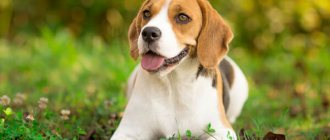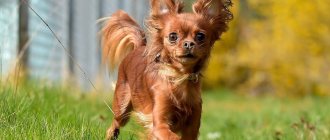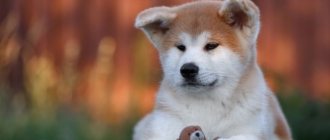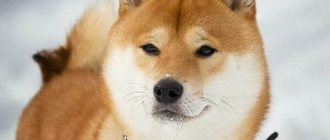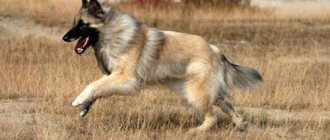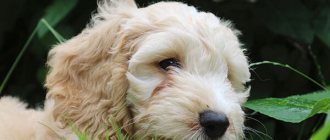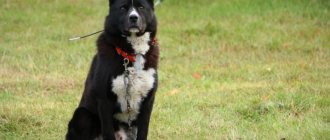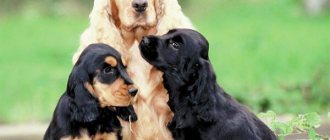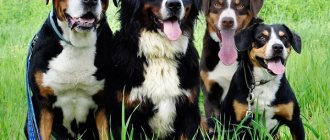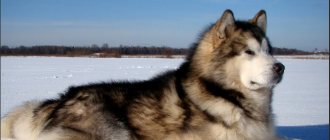The Akita Inu has long won the hearts of dog lovers around the world. Despite its very cute face and plush thick fur, this dog does not like excessive tenderness, intrusiveness and neglect.
The rich history of this breed has left its mark on its character - representatives of this breed are distinguished by confidence, independence, willfulness, high intelligence and devotion. But all this is possible only with the right approach to raising this dog, which at first glance is not the simplest.
Story
The Akita Inu breed is one of the most ancient in Japan . According to archaeologists, this breed appeared in Japan 8 thousand years ago, and for a long time was used for hunting large animals. In the 17th century, the breed gradually turned from a hunting dog to an elite one, as Japanese rulers and retinue began to keep such dogs for guard purposes.
At some point, the veneration of this breed reached the point that in wealthy families, each Akita Inu had its own servant, and they spoke to the dog exclusively calmly, quietly and respectfully.
Over time, the breed became more widespread and accessible. This happened largely due to the fact that the largest and most powerful dogs of this breed began to participate in dog fighting .
Often the Akita Inu's rivals were representatives of another ancient breed, the Tosa Inu - more powerful and hardy dogs resulting from crossing several European breeds. As a result, Akita Inu also began to be crossed with European dogs of the Molossian type, which led to the threat of extinction of the original breed.
In the 20th century, Japanese dog handlers and breeders sounded the alarm and began work to restore the purity of the breed. In 1927, the Akita Inu Preservation Society was even founded, which was able to achieve some success in this direction.
But the Second World War broke out - Akita Inu dogs began to be used on the battlefield due to their fighting qualities and physical strength and strength, but not only - fur coats began to be made from their skins. This led to the fact that by the end of the war, the “pure” individuals bred at the beginning of the century disappeared, and work to restore the breed had to start all over again.
Fortunately, several individuals of real Akita Inu were miraculously found - for several years the owners secretly hid them at home. It was these dogs that marked the beginning of the revival of the breed.
Gradually, the breed gained fame among Europeans, as well as among Americans, whose military bases were located throughout Japan. This is how the breed became popular not only in Japan, but throughout the world .
White
Breeders claim that the white dog was bred in the second half of the twentieth century. The peculiarity of this color was not recognized by international canine services for a long time, therefore, according to the standards, dogs could not participate in competitions for some time. A few decades later, snow-white dogs won their right to participate in dog shows.
Photo from mmitsuhashi’s online account
Pure white dogs that lack pigmented undercoat and colored areas of the body are liked by breeders. There is no need to worry that your white Akita Inu will require more careful grooming. This is a misconception, since she is no different from her own kind. In a white dog, the nose may change to pink, brown, or black.
Such individuals are prone to allergic reactions and dermatitis, so their diet needs to be more carefully selected. Manifestations of allergies can appear in the form of yellow spots on the ear. Judging by the descriptions of qualified breeders, a purebred dog looks impressive, but only with proper care for the hairs, eyes and other parts of the body.
In Japan, white males are never allowed to mate because the offspring are considered culls. Akitas may react inappropriately to vitamin supplements and mineral supplements because they are allergic to most medications. In order not to spoil the skin, special shampoos for wool of light or white shades must be used.
Interesting Facts
- In Japan in the 17th century, there was a decree according to which anyone who dared to offend an Akita Inu was sent to prison, and the killer of a dog of this breed faced an inevitable death penalty.
- The breed has an almost phenomenal memory - dogs remember not only commands and facial expressions of a person, but also the events of their life.
- They don't like to bark for no particular reason. This is why the Japanese have a saying: “If your Akita barks, worry.”
- The surge in popularity of the Akita Inu in our time occurred thanks to the American film “Hachiko”, based on real events. Hachiko is an Akita Inu who lived with her owner, a scientist, who went to the city every day to work. The faithful dog accompanied the owner to the station and returned home, and in the evening he came to meet him. One day the scientist left and never returned - he was overtaken by a stroke right at his workplace. And over the next 9 years, the dog continued to go to the station twice a day and wait for his owner. The old dog died of cancer and heart disease, which is caused by intense grief. After the news of the death, national mourning was actually declared in Japan, and a monument was erected in honor of this extraordinary dog at Shibua Station.
- Dogs of this breed in Japan are considered a symbol of devotion, love and family happiness.
Character traits
Akita Inu is an extremely loyal breed that will defend and protect its home and family to the last, a wonderful family dog, an excellent companion that expects equal and respectful treatment. This is one of the most balanced breeds, has a proud and independent disposition, and rarely displays its emotions even in critical situations.
The intelligence of this breed, which is ahead of many other breeds in this parameter, deserves special mention. These dogs are capable of making decisions, making choices in a specific situation, and sometimes also being cunning like a human being .
Another distinctive feature of this breed is its love of independence, as well as some stubbornness - for example, they do not like to walk on a leash, they may even disappear for several hours, but then they will definitely return home, at home they will choose a place to sleep.
Representatives of this breed treat strangers with respect, hospitability, but still wary - they take a break to better examine the new face and decide on their attitude towards him.
This breed needs training, and it is better that the training is carried out either by an experienced dog breeder or a professional . It is the right approach or a professional trainer that will allow you to raise an intelligent, obedient and devoted dog. Otherwise, there is a danger of Akita Inu dominating the owner.
From the first days, it is important to calmly, firmly and patiently let the new family member understand who is boss in the house. In case of pranks and misdeeds, you should under no circumstances punish him by shouting and, especially, physically - the dog will remember this for the rest of his life, in his eyes the offender will become an enemy on whom he will definitely take revenge someday.
Thus, a strong, strong-willed, self-confident person who knows the intricacies of the character of this breed is suitable as the owner of this dog. Beginning dog breeders are highly discouraged from owning this breed. Breeders very meticulously study candidates for Akita Inu owners. This is due to the fact that there are often cases when owners cannot cope with the pet’s temper and return it back. This, in turn, can have an extremely negative impact on the development of the Akita Inu’s character.
Real opinion.
Pros and cons of the breed
If you see a beautiful Akita Inu dog in the picture, do not rush to buy such a puppy. First, weigh all the advantages and disadvantages of this type of dog and evaluate your capabilities regarding keeping a pet.
Pros:
1. Fearlessness. 2. Security and watchdog qualities. 3. Ability to learn. 4. Cleanliness. 5. No specific smell. 6. Silence, does not bark without reason. 7. Devotion. 8. Love for children. 9. Longevity. 10. Suitable for both apartment and aviary keeping. 11. Inexpensive care. 12. Rarely gets sick.
Standard: description and photo
- Size. The dogs are large in size, height at the withers is from 60 to 70 cm, strong build with correct proportions. The ratio between the height of the withers and the length of the body is 10:11. Bitches have a slightly longer body than males.
- The skull also has correct proportions in relation to the body. The forehead is large, the nose is large and black. Representatives of the white color may lack pigmentation on the nose.
- Jaw The teeth are strong, the lips are dense, the cheekbones are moderately developed.
- The eyes are small, with an “oriental” shape, the outer corners are slightly raised, and brown.
- The ears are quite small, triangular, slightly rounded at the edges, located close to each other. At the very beginning, the ears are lowered, only by six months do they finally rise.
- The neck is thick and muscular, the back is straight and strong, the loin is wide and muscular. The chest is high, with a well-developed rib cage.
- The tail is straight in the first 2 months of life, then curls into a ring and lies on the back.
- The paws are thick, round, dense and strong. The coat is dense and short (about 5 cm).
Next in the photo you can see an Akita Inu dog:
Dimensions, weight and other distinctive features
These dogs are considered quite large animals, and their beautiful appearance sets them apart from other breeds. The height of a male dog at the withers can reach 65-70 cm, and that of a female dog – 58-63 cm. The weight of a mature female dog is 20-45 kg, and that of a male dog – 30-45 kg. However, most dogs have small dark eyes with brown rims and raised upper eyelids.
They have small, pointed, triangular ears, and a large and expressive muzzle. They also have a rather strong and massive back, a muscular neck with a peculiar collar of wool, and a thick tail is always curled into a half ring. Dogs constantly need communication, they need the love and affection of their owner .
Is it aggressive?
Is the Akitu Inu dog an evil or kind dog? Since in ancient times the breed was used first for hunting purposes, then for guarding purposes, and then participated in dog fights, the hunting and guarding instincts inherent in it at the genetic level, if improperly raised and trained, can result in serious difficulties for the owners.
That is why only an owner with a strong, calm character, but at the same time a respectful attitude towards the pet will be able to build the right upbringing . Only thanks to these factors can an Akita Inu become an excellent companion dog, a loyal and intelligent friend who loves his family, children, home, and is ready to protect them to the last.
If the owner does not find the right approach, there is a high risk of getting a pet that is aggressive towards strangers, strange dogs and even children. In addition, the pet will be guided only by its own decisions and desires, and ignore the will of the owner.
IMPORTANT!
It is important to remember that training and education should begin from the very first days and continue until the dog is two years old. In the period from 4 to 8 months, the dog decides who is the dominant owner for it - this person will be the unconditional leader for it.
By the age of two, her maturation ends. If you do not have time to raise and train her by this age, then education at a later date will no longer have an effect, since she is already a fully formed independent individual.
Advantages and disadvantages
However, this breed has many more advantages than disadvantages. In particular, the advantages include such features of the breed as :
- High intelligence and learning ability.
- Fearlessness and protective qualities.
- Innate cleanliness.
- They are wary of strangers.
- A devoted friend and companion of his owner.
- They can live both in an apartment and outdoors in a country house.
Below is a brief description of the main disadvantages of the breed.:
- Willfulness, which in some cases may be excessive.
- Possible aggression towards large dogs.
- A large amount of hair falling out during the molting period.
- Sometimes there are nutritional problems, especially in the selection of dry food.
Training
Akita Inu are very smart, quickly learn new things, and with due diligence they master commands perfectly. However, training will require patience, perseverance and inflexibility from the owner.
If he manages to establish mutual understanding with his pet and properly motivate him to learn, the Akita will be able to achieve outstanding results. Inexperienced owners are better off turning to dog handlers for help.
Training should begin in the first months of life. In the period from 3 weeks to 4 months, the dog develops an attitude towards people, the surrounding world and other animals. This is a key step in training your Akita to become an obedient and friendly pet. It is almost impossible to retrain an adult dog.
It is important to understand that the training process will take a long time. Under no circumstances should you put pressure or get angry with the dog, otherwise the little Akita Inu will withdraw into itself or stop listening altogether.
The best method is encouragement: treats, affection and praise. In addition, during the first year, you should introduce your pet to the open world as much as possible: walk new routes, let him get used to communicating with different people, to noise and crowds.
Varieties
There are two varieties of Akita Inu:
- Japanese - appeared precisely thanks to Japanese cynologists, who concentrated their efforts on restoring the true breed in the post-war period. The Japanese Akita Inu has a special head structure that resembles a triangle. Also distinctive features are small eyes and an upturned nose like a fox.
- American - also appeared in the post-war period, but as a result of the actions of American breeders. Representatives of this variety are larger and taller, have more pronounced fighting qualities, and are better suited as a protector of the owner and his property.
Color variations
The breed has 4 color options:
- Red-fawn with black tips on the hairs.
- Ginger.
- Brindle.
- Pure white.
Three of the four colors (except white) must have a characteristic feature - “urazhiro”. These are white hairs on the sides of the muzzle, on the neck, chest, inner surface of the abdomen and paws.
Sesame
Sesame-colored Akitas are a real rarity in modern cities, although they were common in the mid-20th century. A distinctive feature of a dog of this color is the presence of a red mantle with black braces on the back and a white lower part of the body. Currently, the sesame color of the Akita Inu is never involved in selection, so in Japan it is losing popularity, and in Russia it is almost completely dying out.
Photo from Instagram account nana_akita_inu
Sesame-type coloring is a subtype of red coloring, along which dark black inserts spread. They represent a darkening, a coating different from the main color of the coat of a purebred dog. Additional characteristics of the shade are determined based on the ratio of hairs of black, red, bleached type.
There are two subtypes of sesame - red and black, and only uniform blackening of the body hair is accepted. A dog will be considered culled if there is a saddle cloth on its face. This color, however, is approved by international specialists, but is not considered acceptable on Japanese territory. However, for the last few years this type of color has practically not been found.
Can I keep it in an apartment or outside?
This breed is quite suitable for keeping in an apartment, but at the same time it requires long, hour-long walks at least twice a day. Since initially this breed is characterized by such properties as power, endurance, strength, dogs need to maintain their athleticism and sportiness .
But still, the best thing for them would be to keep them in a large enclosure in a country house, or even better without a leash, but with the opportunity to hide in a warm booth. Long walks will still be necessary, since they will not play or run around on their own.
Brindle color
The Japanese husky with a tiger skin is still exotic for Russia, but in the historical homeland of the animal it is now the most popular. There are several varieties of this suit:
- Blue,
- White (with very light stripes),
- Black (also divided by degree of saturation),
- Redhead.
For a long time there was debate about whether stripes on the head were acceptable, and, ultimately, they came to the conclusion that it was better without them.
To read: Long-haired beauty Shih Tzu: characteristics of the breed
In the red version, paler shades are appreciated, while deep red is undesirable. The most prominent and valued judges at international exhibitions are black and salt and pepper.
How does he relate to children, does he get along with pets?
If Akita Inu can keep a distance with adults and be emphatically respectful, then with children it is as if she returns to childhood - she loves and can play with them for a long time and spend time. This is not without reason - the Japanese elite often used their pets as nannies for children .
If there are other smaller breed dogs or cats in the house, the Akita Inu will get along well with them, especially if they have been raised together since childhood. If a dog of the same breed or size appears in the house, it will be important for the Akita Inu to establish dominance in the first few weeks.
Ginger
Dogs with red hair are distinguished by their photogenicity and striking appearance. Dogs with a similar color necessarily have white areas on the chest, paws, and muzzle. Individuals with snow-white spots in the neck area are allowed to mate, but the presence of wide spots will be considered a disadvantage.
Photo from Instagram account akita.salzburg
The main sign of the colorfulness of the coat is the blackness of the baby of the above breed. Until the age of three months, the dark color of the Akita Inu disappears, and the little creature acquires a rich red coat. The darker the baby's coat color at birth, the richer his coat will become in adulthood.
Small red Akita Inu representatives in childhood do not look like their parents. If a purebred dog was born with a gray undercoat and a dark muzzle, then there is no need to worry, since the color will soon fade and become red.
The appearance of the modern Akita Inu has constantly changed; it was significantly influenced by the time and living conditions of representatives of this breed. The same features affected the quality of the animal’s fur, and breeders for a long time tried to revive the original appearance of the representatives of the breed, since the price and prestige of the puppy depended on this. Judging by the huge number of colors, geneticists were able to develop a unique breed of dog.
Nuances of maintenance and care
There are no serious difficulties in keeping and caring for dogs of this breed, however, there are certain nuances:
- Coat care – since the coat and undercoat are fluffy and thick, these dogs require grooming (clipping and trimming are not applicable). In addition, the coat should be brushed 1-2 times a week. During the molting period, you will have to scratch every day (molting occurs twice a year and can last for several months).
- Washing – in order not to lose the unique waterproofing properties of the coat, it is recommended to wash the dog no more than once a year.
- Nails – trimming is done as needed, depending on how quickly they are worn down (maybe once every two weeks, or maybe more often).
Which owner is it suitable for?
Before purchasing a dog, the future owner should carefully study the description of the Akita Inu and its character.
Despite its unpretentiousness in maintenance, competently raising a pet of this breed will require a lot of effort and time, as well as tenacity of character and a willingness to spend on the services of a trainer.
In addition, the future owner must lead an active lifestyle, love frequent walks and be able to communicate a lot with his pet.
Health and major diseases
The breed is not endowed with any characteristic diseases, and those that are most common can be successfully treated :
- Allergic reactions.
- Bloating or volvulus.
- Dysplasia of the hip or elbow joint.
- Hypothyroidism and skin diseases.
- Blood diseases similar to human hemophilia.
- Eye diseases (cataracts, glaucoma, retinal atrophy).
Life expectancy is approximately 10-12 years. On average, females live 1-2 months longer than males.
General description of the breed
Akita Inu is difficult to classify into any specific category. At different times they were bear hunters, nannies, companions, guard dogs and decorative dogs. This is the largest Spitz breed and one of six on the list of native Japanese breeds protected by the local canine organization. The lifespan of an Akita is from 10 to 14 years.
Photo: klkfavorit.ru
Nutritional features: what is best to feed?
Japanese origin has left its mark on the diet that is most suitable for this breed - rice, fish, seafood, seaweed, vegetables. Chicken, beef, and fermented milk products, which are more familiar to European breeds, can cause allergies. In addition, they do not digest soy contained in dry food well, so choosing dry food is quite difficult. More or less suitable may be one that has only one source of protein - fish or duck.
Boiled sea fish, low-fat cottage cheese, veal, fruits and vegetables are best for puppies. Depending on the age of the puppy, the frequency of feedings will also change - puppies up to two months of age need to be fed 5-6 times a day , by four months the number of feedings should be reduced to 3 times a day. Dogs 6 months and older eat twice a day.
Video
* We invite you to watch a video about the Akita Inu . In fact, in front of you is a playlist in which you can select and watch any of 20 videos about a given dog breed by simply clicking on the button in the upper right corner of the window. In addition, the material contains quite a lot of photos. By looking at them you can find out what an Akita Inu looks like.
In this article:
|
How to choose a puppy?
If you decide to get a dog of this breed, it is best to contact a kennel that specializes in this particular breed. It will be even better if this club or kennel is recognized by the International Canine Organization.
When choosing an Akita Inu puppy, you should consider the following points :
- Choose a puppy from a small litter where all puppies are approximately the same size.
- It is important to familiarize yourself with the pedigree, to study whether there are any genetic diseases or allergies. You should not take puppies from parents who were closely related - this increases the risk of diseases in the puppy.
- By talking with the puppy’s parents, you can roughly understand the psychological portrait of their offspring.
- When communicating with a puppy, it is important to pay attention to how much he makes contact and is interested in the potential owner - if all this is present, then the puppy is ready for a new family.
- Are there any external flaws in the puppy, how active and playful is he, is there an unpleasant odor, are all his teeth and claws intact.
Buy Akita Inu
First of all, you should familiarize yourself with the characteristics of this breed, and also decide why such a dog is needed. In any case, it is necessary to consider the dog as another member of the family who expects to have its share of love and respect. Only this approach can simplify the process of socialization and education of an animal. If you plan to practice breeding work, then it is necessary to take into account all the breed characteristics of the dog.
What to pay attention to
You should not buy Akita Inu puppies secondhand, preferring trusted breeders or clubs, as well as kennels. It is very important that the animal not only has an appropriate appearance, but also accompanying documents. When choosing an animal, you should pay attention to a number of factors, such as:
- A quality selection of a puppy is not possible without a specialist, especially if breed characteristics come first.
- You should pay attention to the average characteristics of the puppies.
- If the parents are close relatives, then it is better not to buy such a puppy.
- It is very important to study the behavior of the puppy's parents, since all data is inherited.
- The breeder must provide the puppy with all the necessary documents: birth certificate, certificate of achievements of his parents, information about hereditary diseases, as well as all information about vaccination.
When choosing a puppy, you should give preference to one that makes contact with a person, while showing interest and a desire to communicate.
Akita Inu puppy price
The price of puppies of this breed depends on the class of the puppy:
- Show class puppies can cost from 3 to 10 thousand dollars.
- Breed class puppies are valued at $2.5-4 thousand.
- Pet class puppies are priced at a minimum of $350.
What is the price range for puppies?
The cost of puppies depends on its class. There are three classes :
- Show class - price from 3 to 10 thousand dollars. These are dogs with a pure pedigree, without physical flaws, completely healthy, best suited for exhibitions.
- Breeding show class - price from 2.5 to 4 thousand dollars. Similar to show class, but used for breeding.
- Pet class – price from 1 to 2 thousand dollars. They have some kind of cosmetic defects (for example, flaws in color, incorrect bite), so they cannot participate in exhibitions.
Approved colors
All of the above are united by the fact that no matter what continent the animal lives on and what size it has, there are only four acceptable colors according to the World Canine Federation:
- brindle,
- Sesame,
- Snow-white,
- Red-fawn.
But not everything is so simple! There are three more versions of the standard and they are all presented by different organizations. AKIHO allows the presence of the following colors in the color:
- white,
- spotted,
- black,
- ginger,
- sesame,
- brindle.
NIPPO accepts all of the options listed above, but excludes spotted Akita Inus. AKIKIO allows various options for the following colors:
- Black,
- White,
- brindle,
- Ginger,
- Sesame.
Each author of the listed standards has his own vision of the beauty of the Japanese husky, and he substantiates it with arguments. The difficulty of determining one color or another is also due to the fact that the colors of dogs can change with age. Only the snow-white fur remains unchanged.
